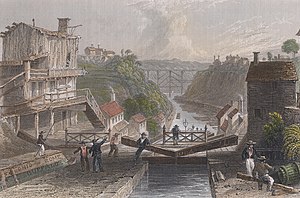Cotton, at first a small-scale crop in the South, boomed following Eli Whitney's invention in 1793 of the cotton gin, a machine that separated raw cotton from seeds and other waste. Soon, large plantations, supported by slave labor, made some families very wealthy.
Millions moved to the more fertile farmland of the Midwest. Government-created national roads and waterways, such as the Cumberland Pike (1818) and the Erie Canal (1825), helped new settlers migrate west and helped move western farm produce to market. The Whig Party supported Clay's American System, which proposed to build internal improvements (roads, canals, harbors) protect industry, and create a strong national bank. The Whig legislation program was blocked by the Democrats, however.
President Andrew Jackson (1829-1837) opposed the Second National Bank, which he believed favored the entrenched interests of his enemies. When he was elected for a second term, Jackson opposed renewing the bank's charter, and Congress supported him. Jackson opposed paper money and demanded the government be paid in gold and silver coins. The Panic of 1837 stopped business growth for three years.
Railroads were, by far, one of the most important contributions to the economy. Many contrasting views exist regarding whether the railroad was "indispensable" or not, but it was undoubtedly very important. The railroad paved the way to new developments in running large-scale business operations, creating a blueprint for future businesses to use. They were first to encounter managerial complexities, labor union issues, and problems of competition. Due to these radical innovations, the railroad became the first large-scale business enterprise.
Panics did not curtail rapid U.S. economic growth during the 19th century. Long term demographic growth, expansion into new farmlands, and creation of new factories continued. New inventions and capital investment led to the creation of new industries and economic growth. As transportation improved, new markets continuously opened. The steamboat made river traffic faster and cheaper, but development of railroads had an even greater effect, opening up vast stretches of new territory for development. Like canals and roads, railroads received large amounts of government assistance in their early building years in the form of land grants. But unlike other forms of transportation, railroads also attracted a good deal of domestic and European private investment.
Some people made fortunes overnight, but many people lost their savings. Nevertheless, a combination of vision and foreign investment, combined with the discovery of gold and a major commitment of America's public and private wealth, enabled the nation to develop a large-scale railroad system, establishing the base for the country's industrialization.

No comments:
Post a Comment